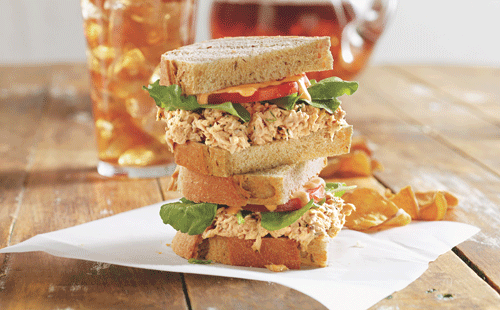The dog days aren’t over: Staying in shape and eating smart during injury recovery

Photo courtesy of Runner’s World
This salmon with chili aioli sandwich is a perfect example of delicious food packed with anti-inflammation omega-3 fatty acids.
August 31, 2014
For runners, injuries rank high on the list of worst nightmares. This is especially true when the cause of injury is way beyond your control.
For instance, if you pull a muscle or get the dreaded shin splints from overrunning or overstretching, you probably know, deep down inside the layers of denial, that the injury is at least partially your own fault. However, if you manage to trip and bust your knees on the sidewalk or break a toe while playing a particularly brutal game of barefoot soccer, the aftermath of the injury is infuriating.
Fortunately, I haven’t been injured this summer, but I was inspired to write this post when my friend rolled her ankle at a summer camp. The worst thing is that she had been running – actually exercising! – when the tragedy happened, and now her ankle was going to prevent her from continuing to exercise.
If you’re in this situation, you don’t have to give up yet! There are still a lot of ways to stay in shape until your injury heals, no matter the severity of the damage. Treatment is also important to speed healing, although the method of therapy will vary depending on the type of injury. For example, gentle stretches will help improve shin splints, but hamstring strains cannot be stretched out until the muscle heals completely.
You can work around numerous injuries by engaging in non-impact exercises. For example, biking, swimming and core training all have minimal impact. If you don’t usually do these workouts, they will actually help you build muscles that may not be exercised much and prevent future injury.
During the healing process, ice packs are also an invaluable part of your routine of injury prevention and recovery. Ice slows down the blood circulation of the body part to which it is applied, which in turn reduces inflammation and speeds recovery.
However, it’s important to remember that the only foolproof way to completely recover from an injury and prevent its return is rest. No matter how much you want to exercise, you have to stay away from the temptation until your injury is fully healed. Otherwise, you’ll be haunted by the injury for much longer than originally necessary.
Believe it or not, there are also some foods that are proven to help your body on the recovery path. Essential fatty acids such as omega-3 can help reduce inflammation and muscle atrophy during the healing process; some foods rich in omega-3 fats are salmon, walnuts and flax seeds, among other healthy options.
A balanced palate is also necessary; it’s important not to skimp on protein or cut down calories while your body is recovering. This might seem a little unreasonable, since some people will try to eat less to compensate for the lack of exercise. Nevertheless, your body actually needs protein to avoid muscle atrophy, and calories are necessary for the healing process. Some excellent sources for protein that also contain a good number of calories are eggs, seafood and lean meat.
Finally, there are a few categories of food that should be avoided post-injury. According to Runner’s World, snacks and desserts loaded with sugar can increase the levels of fat in your blood because your body will be less efficient at processing sugar while an injury is healing. In addition, you can frequently find omega-6 fatty acids in fried and fatty snacks. Unlike omega-3 fats, omega-6 can actually increase inflammation, the complete opposite of what you want.
All in all, injuries can become quite exasperating, but it’s important to take the right steps to allow your body to recover. Along the way, by no means do you have to give up exercise and eating healthy. There are also tons of other sources on the Web – other than Runner’s World, which I follow religiously – that offer alternatives to regular exercise during the healing period. It’s important to remember that you will eventually get over these difficulties; tomorrow will be a better day.





